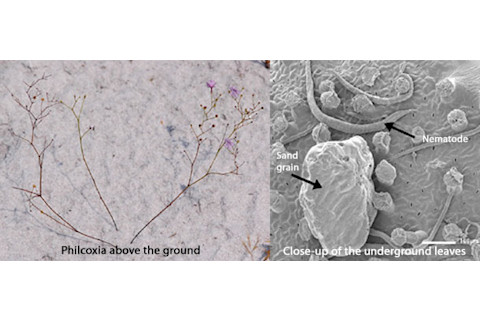couldn’t look more unassuming. It’s a small herb that lives in Brazil’s Campos Rupestres region, a sparse plateau of rocky outcrops and white sands. All you’d see of it are a handful of twigs sticking out from the grains, topped with small purple flowers and even smaller leaves. You wouldn’t think that it’s the type of plant that can kill animals. To find Philcoxia’s grisly secret, Caio Pereira had to look underground. The plant biologist from Unicamp, Brazil, found that the planttraps and digests tiny worms with sticky underground leaves. Plants have evolved to eat animals at least six times, and over 600 species of them now do so. They catch their prey with slipperywater-filled pitchers, fast-snapping traps, sticky leaves and sucking bladders. Their strategies are diverse, but they all tend to grow in areas that are poor in nutrients. For example, familiar species like the Venus’ fly trap and the sundew live in bogs and swamps. In such inhospitable environments, these plants supplement their supplies of nitrogen, phosphorus, and other nutrients by feasting on the flesh of animals. Philcoxia is no different. When Peter Taylor described the plants in 2000, he noted that they have several features that resemble those of other meat-eating species. Its mountain home is poor in nutrients and frequently starved of rain. Its roots are unusually sparse and lack the fungal partners that help other plants to survive. And it has tiny underground leaves – just a millimetre wide and coated with sticky glands, of the type found in other carnivorous plants. There was just one problem. There were no signs of captured animals, or bodies nearby. If Philcoxia ate animals, it wasn’t doing so obviously. In 2007, Peter Fritsch found a possible answer. He noticed nematode worms stuck to the underground leaves, and reasoned that the plant was trapping and digesting them. Pereira, working with Fritsch, has now confirmed this hypothesis. He found that Philcoxia’s underground leaves are littered with the bodies of dead nematodes. To check that the deaths aren’t coincidental, Pereira bred nematodes so that their bodies were full of nitrogen-15 – a rare and heavier-than-usual version of the element. He then “fed” the nematodes to Philcoxia. Two days later, Pereira found that 15 percent of the nitrogen-15 in the worms has been incorporated into the plant’s leaves. It was clear proof that Philcoxia was digesting the nematodes and absorbing the remains into their bodies. Many meat-eating plants digest their prey with high concentrations of enzymes called phosphatases. Philcoxia does so too. Pereira found loads of the enzymes on Philcoxia’s leaves, which means that the plants are probably digesting the nematodes directly. Pereira still wants to find out how Philcoxia lures its prey towards its traps. But for the moment, he has shown that its diet of worms greatly raises the level of nitrogen in itsleaves, boosting it even above the levels of neighbouring plants that aren’t carnivorous. That’s interesting, because some scientists have suggested that eating animals is a relatively inefficient way of coping with nutrient-poor environments. This would explain why carnivorous plants are relatively rare. But Philcoxia clearly shows that a fleshy menu can provide more nutrients the strategies of other plants in the same conditions. Indeed, Philcoxia’s murderous habits suggest that we may have underestimated the true number of meat-eating plants in the world. After all, if this rare species feeds on microscopic prey using hidden traps, perhaps other plants do so too. As Mark Chase wrote a few years back, “we may be surrounded by many more murderous plants than we think”. Reference: Pereira, Almenara, Winter, Fritsch, Lambers & Oliveira. 2011. Underground leaves of Philcoxia trap and digest nematodes. PNAS http://dx.doi.org/10.1073/pnas.1114199109More on meat-eating plants:

Philcoxia













